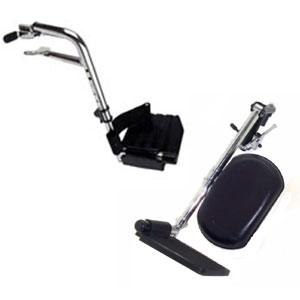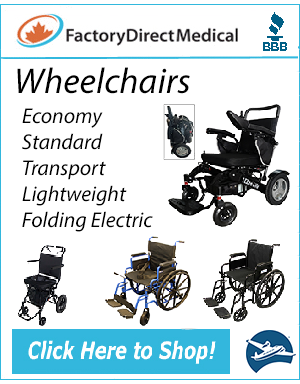
Wheelchair Footrests
There are two or three types of foot support for a wheelchair. The two most common are generally known as "footrests" and "legrests". A footrest consists of a footrest hanger and a footplate for the user's foot to rest on and a legrest has a "calf pad" mounted on an elevating hanger to support the lower leg when elevated and the same options for a footplate as the footrest will have.
Proper support of the feet and legs is important to the comfort of the wheelchair user and long term use of footrests/legrests that are not set up properly can lead to pain in the lower back and excess pressure on the buttocks or the lower thigh area.
Footrests
Footrests are the most common type of front rigging on a wheelchair and are pretty basic. Footrest for wheelchairs usually are removable and swingaway to the side to make transfers easier. They are equipped with a choice of the styles of footplates available to support the user's feet.
The footrest hangers are usually available in two or three different angles to best meet the user's needs. Kid's wheelchair footrests are often angled at 90° to keep the feet directly below the knees which are positioned at 90° to the thigh. While 90° is the optimum position for everyone, it isn't practical for adults as their lower legs are usually too long to be set at 90°. So adults usually have a choice of 70° or 60° hangers to keep the hangers clear of the swivelling casters and keep the seat height at a reasonable height.
Legrests
Legrests aren't nearly as common as footrests on most wheelchairs but are almost standard equipment on relining and tilting wheelchairs as most users who benefit from tilt and recline will also benefit from elevating legrests. Legrests are pretty heavy so they aren't commonly used on the lightweight wheelchairs.
Legrests have one characteristic that prevents them from being a prefect option for those who need elevation of their feet. It is difficult to set the footplate position to be comfortable in all of the positions they can be set. Because of the position of the user's knee and the physics involved when it is straightened, the footplate adjustment needs to be longer when the leg is extended than when it is bent.
If the footplate is set properly when extended, it will be hitting the floor and too long when lowered. If the footplate is set correctly when the knee is bent, it will be too short when elevated and force the user's knees up into the air and put pressure on the buttocks.
Articulating Legrests
Articulation solves the issue of footplate length when the elevation is changed by changing the distance to the footplate. As the legrest is elevated the footplate distance increases and when lowered the footplate distance is shortened.
While articulating legrests are the best option for those who require legrests, both the standard legrests and the articulating type are still available on many models of wheelchairs.
Fixed Front End Wheelchairs
Sports wheelchairs and rigid wheelchairs that are built for performance and light weight do not normally use footrests or legrests at all. Wheelchairs with a fixed front end normally have an angle adjustable footboard mounted directly to front of the wheelchair frame to support the weight of the legs.
Footplate Options
Standard footplates can be made of aluminum or a plastic composite material and are set about 90° to the downtube of the footrest/legrest hanger. Footplates come in different sizes but generally support from the back of the user's heel to around the ball of the foot.
Angle adjustable footplates are usually aluminum and will have two or three adjustment features depending on the model of wheelchair.
Angle adjustable footplates are generally longer and support more of the foot than standard footplates plus can sometimes be mounted farther forward or backward than the the standard position.
The angle of the plate in relation to the downtube can be adjusted through a large range of angles from almost touching the floor at the toe to almost vertical with the heel almost at the floor as the user requires.
In some case the angle adjustable footplates can also be angled so that the left side of the individual footplate can be higher or lower than the right side of the footplate to accommodate the user.
Footboards are sometimes added to footplates to provide a larger full width platform for the feet to rest on and will be at the same angle as the footplates they are attached to. Footboards are most common on sports chairs that have the foot support built right into the wheelchair and are mounted to the frame rather than a footrest/legrest.



 Online Vendors
Online Vendors  US Online Vendors
US Online Vendors 

